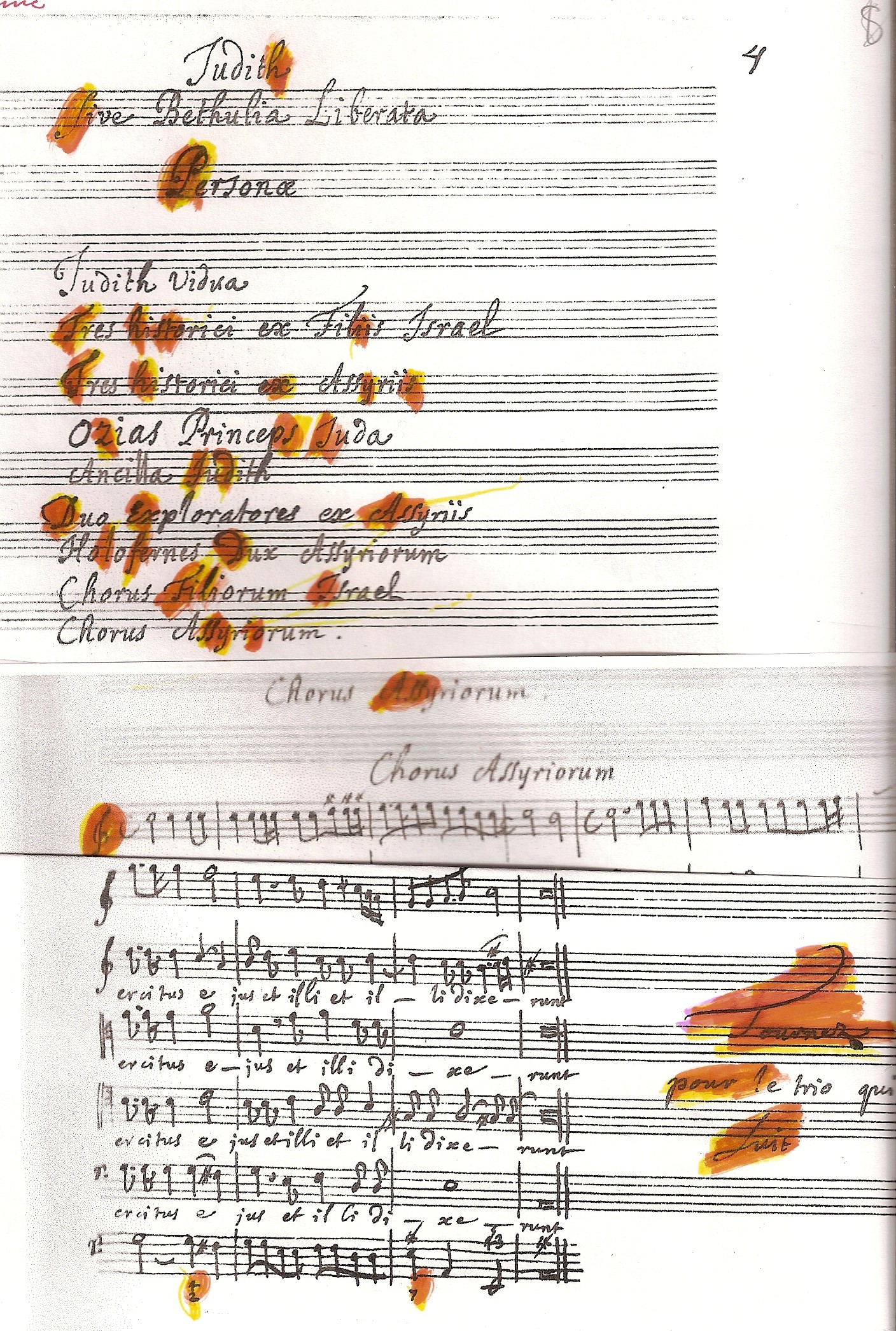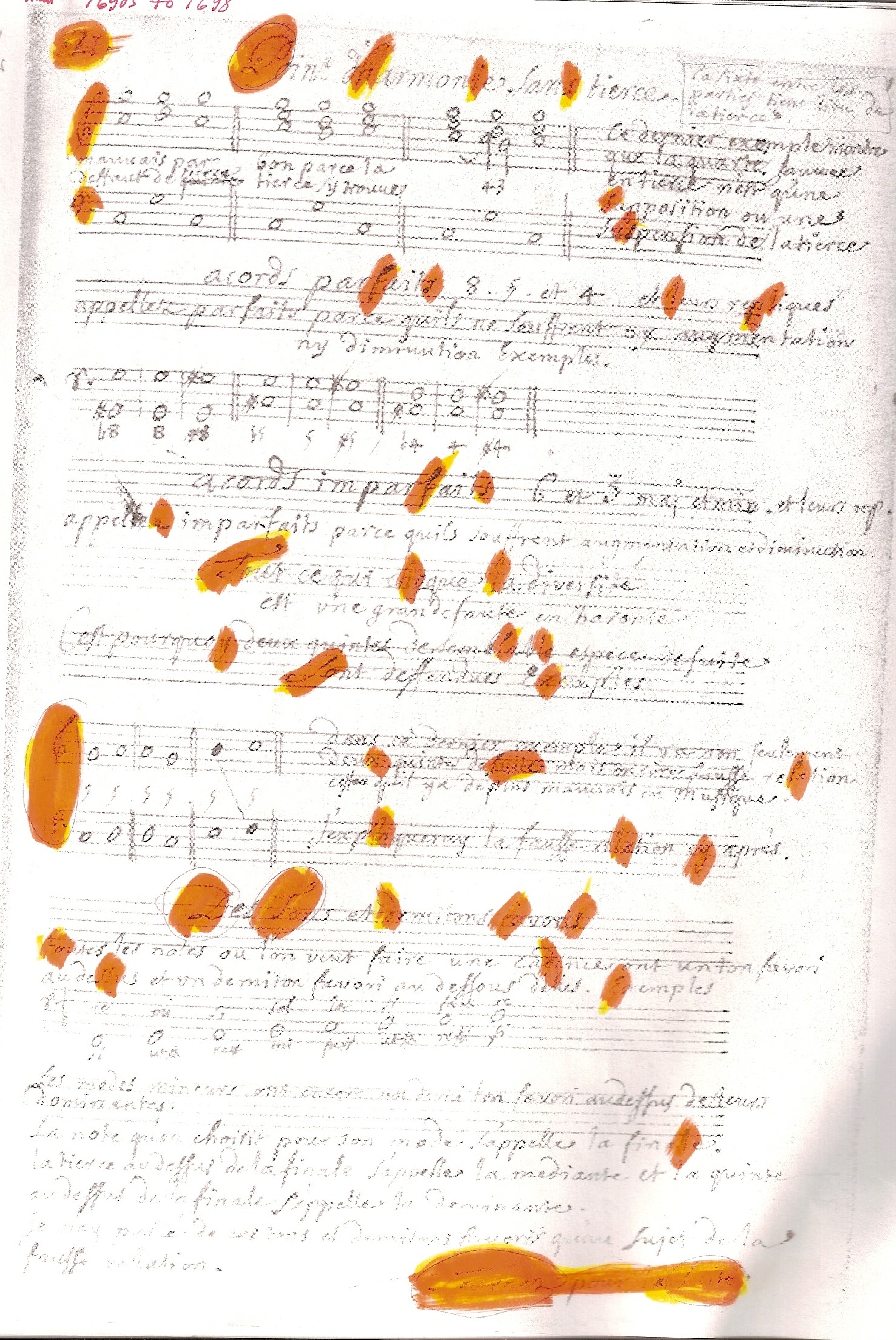 The
Ranums'
The
Ranums'
Panat Times
Volume 1, redone Dec. 2014
Discovered at the Lilly Library: manuscript "XLI," an autograph theoretical work by Marc-Antoine Charpentier (late 1698)
Prologue: Recognizing Charpentier’s handwriting in scans of manuscript "XLI"
Some years ago, I agreed to read and comment upon the transcription and translation of a French manuscript being done by Carla E. Williams, a doctoral candidate in musicology at the University of Indiana, Bloomington.
In early November 2009, Ms Williams sent me two computer files: her transcription and translation, plus scans of the manuscript itself, which bears the title Traité d’accompagnement. As I scrolled through her transcription, I came upon the names of Étienne Loulié (on whom I had worked back in the 1980s (1) and Charles Masson (a friend of Sébastien de Brossard, someone I have likewise studied (2). Most intriguing of all were some references to "feu Mr Charpentier," the "late Monsieur Charpentier."
Since one of the pillars on which the anonymous Traité is constructed is a discussion of major and minor scales and the fundamental chords of each key/mode, I was not overly surprised to find references to Loulié’s and Masson’s published works. Those books included brief presentations of the major and minor scales whose existence their mutual friend, Brossard, claimed to have deduced back in 1684 or 1685.(3)
I checked the images of the original manuscript that Ms Willams had sent me: that was indeed what the anonymous author of the Traité de l’accompagnement had written. Still, I was puzzled by the allusion to the “Principes de Charpentier” (p. 18 of the Traité, my emphasis). To what book or manuscript might the author be referring? Loulié wrote a book called Élements ou Principes, but no such book by Charpentier is known.
"While I'm at it, I might as well scroll through the entire file,” I said to myself, "to get a visual impression of the source. It might help Ms Williams to date her treatise more accurately than simply ‘post-1710' — the date of the latest publication mentioned." Toward the end of the Traité, the handwriting changed abruptly: I was looking at the hand of Marc-Antoine Charpentier! The mature hand he used at the Sainte-Chapelle!
Juxtaposing a printout of this little manuscript appended to the Traité, and some pages from the Minkoff facsimiles of Charpentier’s compositions for the post-1698 years, I compared the handwriting of the two sources. First I highlighted in orange the distinctive capital letters that Charpentier used for the opening pages of Judith and Salomon; then I highlighted the same letters as they appeared in the little manuscript appended to the manuscript on which Ms Williams is working. I moved on to lowercase letters, to the musical notation itself, and to the characteristic "Tournez" that Charpentier was wont to put in the lower right-hand corner of a page, or the large "fin" he placed at the end of some of his works. Soon both the photocopied manuscript and the photocopied pages from the facsimiles were peppered with large orange circles and ovals.
Here are two of the photocopies I highlighted during that initial comparison:
--- the first page of Judith; right, fol. 1 recto of the Charpentier manuscript, courtesy Minkoff France, Mélanges Charpentier

and a page from the Lilly manuscript, Courtesy Lilly Library, Indiana University, Bloomington, Indiana

Click here for a closeup comparison of the handwriting in Judith and in the Lilly manuscript.
There is simply no doubt: this little theoretical text is a Charpentier autograph.
I informed Ms Williams of the discovery. A few days later, Orest and I set off for Bloomington, and we went to the Lilly Library of the University of Indiana, to examine the volume in her presence. Back in Baltimore in late November, and working on into early December 2009, I assembled the evidence then available in a file titled "Report." I shared the file with Ms Williams in late January 2010, along with a variety of bibliographical information and research suggestions. For a year I kept silent about the discovery and its contents, so that she could complete her dissertation without having to take into account the context problems explored in this Musing.
The Report is the departure point for the cluster of Musings I will be posting here this fall, to celebrate the first anniversary of the discovery. Those initial observations and hypotheses have been honed and expanded by a year of private thought and study. In this Musing, and in the other related ones that will soon appear, I have been careful to restrict my discussions to Marc-Antoine Charpentier the man, to how he put his ideas on paper, and to the activities of members of his close circle during the 1690s. That is my competence. I have been equally careful to avoid discussing the contents of both the Traité d’accompagnement and the Charpentier autograph, and what they can tell scholars about harmonic theory, 1698-circa 1720. That is Ms Williams's subject and competence. (She has since defended her dissertation.)
Notes:
1. Patricia M. Ranum, "Étienne Loulié (1654-1702), musicien de Mademoiselle de Guise, pédagogue et théoricien, Recherches sur la musique française classique 25 (1987), pp. 27-76, and 26 (1988-90), pp. 6-49.
2. Patricia M. Ranum, "À la recherche de son avenir: Sébastien de Brossard à Paris, 1678-1687, in J. Duron, ed., Sébastien de Brossard, Musicien (Paris: Klincksieck, 1998), pp. 283-306.
3. Ranum, "Loulié" (1987), pp. 50-51.